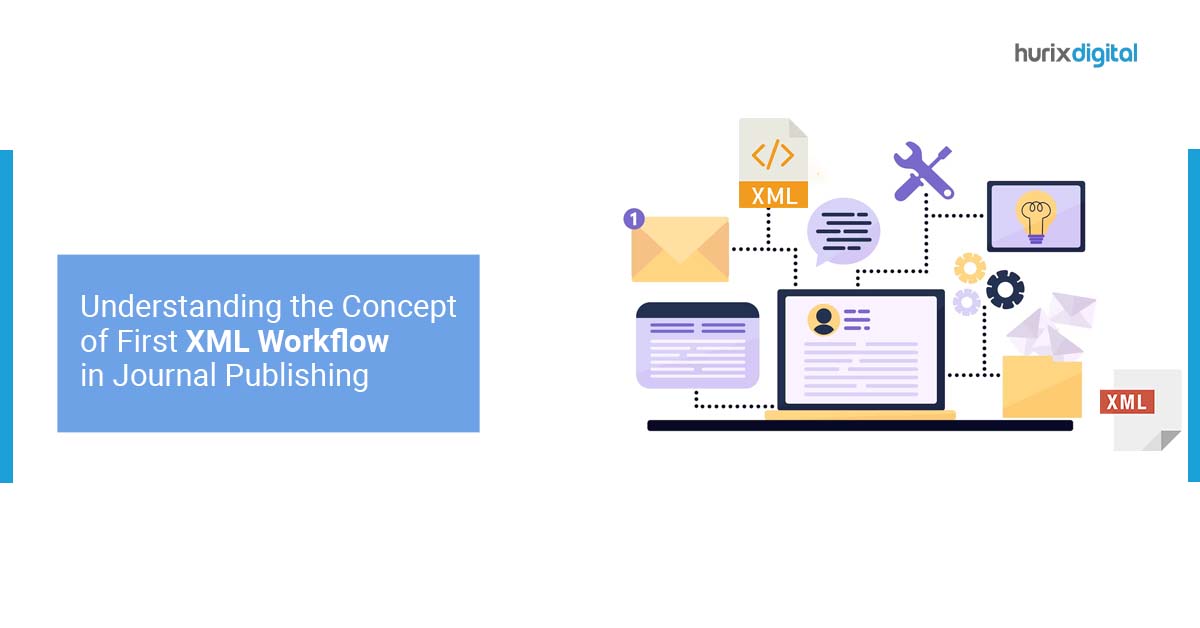
Understanding the Concept of First XML Workflow in Journal Publishing
In the rapidly evolving world of journal publishing, efficient and streamlined workflows are essential for maintaining high-quality content delivery.
One critical component of modern publishing is using XML (Extensible Markup Language) to structure and manage content. XML workflows facilitate seamless collaboration, enhance data consistency, and improve content accessibility across multiple platforms.
Whether new to XML or looking to optimize your journal publishing processes, understanding and implementing your first XML workflow can significantly improve productivity and reduce errors.
This guide will walk you through the basic steps of setting up an XML workflow tailored to journal publishing’s specific needs.
Table of Contents:
- Key Stages of an XML Workflow in Journal Publishing
- The Rise of Journal Publishing
- Traditional Publishing vs. First XML Workflow: A Game-Changer for Efficiency
- Breaking Ground with the First XML Workflow
- Stepping into the First XML Workflow for Journal Typesetting
- Conclusion
Key Stages of an XML Workflow in Journal Publishing
XML (Extensible Markup Language) workflows involve processes designed to manage content from creation to delivery efficiently. Understanding the typical stages of an XML workflow helps ensure consistency and accuracy throughout the journal publishing process.
Below is an outline of each major step in a standard XML workflow:
- XML Document Creation: The workflow begins with creating an XML document using an XML editor or authoring tool. The document is structured using XML tags, which define the elements and their relationships within it.
- XML Document Validation: Once the XML document is created, it may need to be validated against a specific XML schema or Document Type Definition (DTD). This step ensures the document adheres to the defined structure, data types, and constraints.
- XML Document Editing: XML documents often require modifications or updates. The workflow includes editing an XML document by inserting, deleting, or updating elements, attributes, and values. It is achievable using both manual and automated processes.
- XML Document Transformation: XML documents can be transformed from one format to another using technologies like XSLT (Extensible Stylesheet Language Transformations). Transformation allows you to extract, restructure, or present data from an XML document in some other format, such as HTML, PDF, or any other schema of XML.
- XML Document Parsing and Processing: Software applications must parse and process XML applications in many workflows. This would entail extracting information from the XML document, performing calculations or operations, and generating outputs or performing specific actions based on the data contained within the XML.
- XML Document Integration: XML is commonly used for data interchange between different systems or applications. Integration involves sending or receiving XML documents between various software components or systems, enabling seamless communication and data exchange.
- XML Document Storage and Retrieval: XML documents may be stored in databases, file systems, or document management systems for future retrieval and reference. Appropriate storage and retrieval mechanisms are employed to ensure efficient XML data management.
It should be mentioned that XML workflows can differ significantly between projects or applications. At different stages of the workflow, different tools, technologies, and processes might be used to carry out the necessary tasks related to XML.
Also Read: Why Do Publishers Need An XML Workflow?
The Rise of Journal Publishing
Journal publishing has a long and rich history that dates back several centuries. A brief overview of the key milestones in the history of journal publishing is provided below
1. Early Journals
The first academic journal, the Journal des Sçavans, was established in France in 1665. This was followed by the Philosophical Transactions of the Royal Society in England in 1666.
2. 18th and 19th Centuries
Academic journals mushroomed in the 18th and 19th centuries with discoveries of new fields of knowledge and scientific discovery. Many of these journals were published by learned societies; societies meant to control programs that furthered the pursuit of knowledge in certain fields.
3. Rise of Commercial Publishing
Commercial publishers became increasingly important players in journal publishing in the late 19th and early 20th centuries as they developed an awareness that this was a field in which they might profit.
4. Digital Publishing
With the advent of the Internet at the tail end of the 20th century, journal publishing also underwent a mutation. It allowed for rapid electronic distribution of articles to a much larger audience than possible.
Electronic publishing also facilitates article searching and retrieval while allowing for new business models, including open access.
5. Open Access
Another important initiative started in the early 2000s is open access. This right allows free and easy access to all research results, even if one may not have access to money to do so.
Open-access publishing has gained a lot of momentum lately because funding agencies and more institutions are requesting researchers to freely make their work available.
6. Future of Journal Publishing
Technologies continuously developing are just the tip of the iceberg. Funding models will change, and reader expectations will define journal publishing in the future.
Some of the trends that will define journal publishing in the future include open science, machine learning, AI, and the increasing emphasis on data in academic research, among many others.
Traditional Publishing vs. First XML Workflow: A Game-Changer for Efficiency
Journal publishing has evolved significantly from traditional print to digital XML publishing over centuries. Here’s a brief look at how the landscape has transformed:
- Manuscript Submission: Authors would submit their manuscripts to the journal editor by mail or fax.
- Manuscript Review: The editor would review the manuscript and send it out for peer review.
- Peer Review: Peer Reviewers evaluate the article, give constructive criticism, and decide whether to accept, reject, or request amendments to the paper.
- Manuscript Revision: When the revised paper is accepted, the author incorporates the indicated corrections and resubmits the paper.
- Copyediting: When the manuscript gets approved, it is forwarded to a copy editor to hold the page regarding grammar, spelling, and uniformity.
- Typesetting: The manuscript that underwent copy editing would then be sent for typesetting, where the text would be arranged, and images and pictures would be inserted to create the final layout of the article.
- Proofreading: Proofreading would be done on the typeset copy of the article before publishing to check for mistakes.
- Printing: The last established typeset article was submitted to the printer, who, after printing the article, sent it back to the publishing house.
- Distribution: Finally, the publisher would distribute the printed journal to subscribers and libraries.
Also Read: A Beginner’s Guide to XML Content Development
Breaking Ground with the First XML Workflow
Publishers recognized the need for a quicker, more reliable system, leading to the introduction of the First XML Workflow. Using XML as a universal format, publishers could streamline content preparation and distribution, increasing productivity and cutting costs.
Here’s how XML transformation brings efficiency:
- Standardization: XML serves as a consistent, machine-readable format for journal articles.
- Flexibility: The format separates content from presentation, making it easy to repurpose across different platforms.
- Efficiency: Automating the workflow reduces human intervention, ensuring AI in typesetting optimizes the process.
- Accessibility: Semantic markup in XML allows search engines to index articles better, improving visibility.
Stepping into the First XML Workflow for Journal Typesetting
Almost instantly, an article moves effortlessly from one workflow stage to another in a modern XML typesetting, which brings to the picture the use of XML to automate typesetting.
Let’s take a brief overview of the process involved:
- Manuscript Submission: Any author submitting an article would send it in formats such as Word or LaTeX, which are already prepared for XML conversion.
- Styling and Conversion: Using specialized tools, the manuscript is mapped to an XML schema, converting elements like headings, images, and equations into structured data.
- XML Transformation for Typesetting: Stylesheets are applied to define visual presentation, and any special formatting, such as MathML for mathematical content, is embedded.
- Typeset Document Generation: Automated transformations arrange content into typeset-ready formats.
- Final Output: The document is exported to a format like PDF for print or digital distribution, maintaining its underlying structure for easy reuse.
The XML document is an intermediary format throughout this workflow, allowing data to flow efficiently without compromising its organization or semantics. Automation further streamlines the process, enhancing output consistency and reducing turnaround time—a win-win for publishers and readers alike.
Conclusion
As the publishing landscape shifts, adopting XML paths will be necessary to survive in the changing dynamics of the digital economy. Open access, the possibilities of scaling up, and the increasing need to produce good work all reinforce the value of XML in securing your publishing processes against obsolescence.
Integrating XML workflows helps publishers improve content reach, reduce production time, and increase productivity at all levels of the publishing chain.
Hurix Digital is leading the way in enabling publishers to adopt and maximize XML workflows for efficient journal publishing. Given our decryption content, digital publishing, and subsequent technology content, we can walk you on the entire journey of adopting XML.
Whether fine-tuning your typesetting services, improving access to your content, or automating your editorial processes, our team assures you there will be no outrunning in the future.







